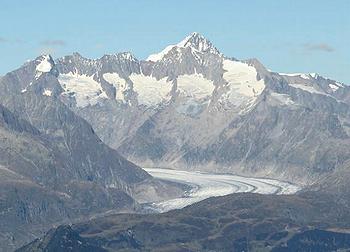
GLAND, Switzerland, May 10, 2019 (ENS) – Glaciers are forecast to vanish from almost half of all UNESCO World Heritage sites if business-as-usual greenhouse gas emissions continue, finds the first global study of World Heritage glaciers, co-authored by scientists from the International Union for the Conservation of Nature, IUCN.
These are some of the world’s most famous glaciers, such as the Grosser Aletschgletscher in the Swiss Alps, Khumbu Glacier in the Himalayas and Greenland’s Jakobshavn Isbrae.

The study, “Disappearing World Heritage glaciers as a keystone of nature conservation in a changing climate,” is published in the journal “Earth’s Future.”
It combines data from a global glacier inventory, a review of existing literature and sophisticated computer modeling to analyze the current state of World Heritage glaciers, their recent evolution, and their projected mass change over the 21st century.
The authors predict glacier extinction by 2100 under a high emission scenario in 21 of the 46 natural World Heritage sites where glaciers are currently found.
Even under a low emission scenario, eight of the 46 World Heritage sites are projected to have no ice at all by the year 2100. The study also expects that 33 percent to 60 percent of the total ice volume present in 2017 will be lost by 2100, depending on the emission scenario.
“Losing these iconic glaciers would be a tragedy and have major consequences for the availability of water resources, sea level rise and weather patterns,” said Peter Shadie, director of IUCN’s World Heritage Programme.
“This unprecedented decline could also jeopardize the listing of the sites in question on the World Heritage list. States must reinforce their commitments to combat climate change and step up efforts to preserve these glaciers for future generations,” Shadie said.
Several landscapes found in World Heritage sites will be impacted by rising temperatures.
Los Glaciares National Park in Argentina contains some of the largest glaciers on Earth and a very large ice loss – about 60 percent of the current volume – is predicted by 2100 within this site.
In North America, Waterton Glacier International Peace Park, Canadian Rocky Mountain Parks and Olympic National Park could lose more than 70 percent of their current glacier ice by 2100, even under drastically lowered carbon dioxide (CO2) emissions.
In Europe, the disappearance of small glaciers is projected in the Pyrénées – Mont Perdu World Heritage site before 2040.

Te Wahipounamu, a World Heritage Site in the southwest corner of New Zealand’s South Island, which contains three-quarters of New Zealand’s glaciers and four national parks, is projected to lose 25 percent to 80 percent of the current ice volume over the course of this century.
The authors emphasize the key role that glaciers play for ecosystems and societies on a global scale. They say glacier conservation could serve as a motivation to tackle climate change.
“This study points out how the conservation of World Heritage glaciers could serve as leverage and a target to tackle the unprecedented issue of climate change,” the authors write. “Glaciers are more than disappearing passive climatic indicators. They are key components of planetary ecosystems that influence global climate and sea level, as well as water fluxes, human activities, or biodiversity at the regional scale.”
“The conservation of these iconic endangered features could thus mobilize global‐scale conservation and climate mitigation benefits,” the authors believe. “In this context, we show how drastic reduction of emissions will rapidly curb melt rates and safeguard a large glacier volume on the long term.”
The authors also developed the first inventory of glaciers on the UNESCO World Heritage list, documenting about 19,000 glaciers present in 46 out of the 247 natural World Heritage sites.
“To preserve the iconic glaciers found in World Heritage sites, we urgently need to see significant cuts in greenhouse gas emissions. This is the only way of avoiding long-lasting and irreversible glacier decline and the related major natural, social, economic and migratory cascading consequences,” said Jean-Baptiste Bosson, lead author of the study and member of IUCN’s World Commission on Protected areas.
“This study on glacier decline further emphasizes the need for individual and collective actions to achieve the mitigation and adaptation aspirations of the Paris Agreement on climate change,” Bosson said.
Climate change is the fastest growing threat to natural World Heritage sites, according to the IUCN World Heritage Outlook 2 report. The number of sites threatened by climate change has doubled between 2014 and 2017.
Copyright Environment News Service (ENS) 2019. All rights reserved.
© 2019, Environment News Service. All rights reserved. Content may be quoted only with proper attribution and a direct link to the original article. Full reproduction is prohibited.
